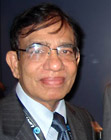
The Salt in your Diet

America has a love affair with salt consumption. Same for Indian Americans too. Between the pickles and pretzels, curries and cookies, plenty of salt is ingested every day by all of us. We have a habit of sprinkling the white powder on anything and everything, whether it is the peanuts you receive in a plane or the sweets you make at home. I saw one of my colleagues dabbing salt from a salt shaker on the cut-up grapefruit while she was eating breakfast with me in our hospital cafeteria. “Oh, it increases the sweetness of the fruit. You should try it,” she said.
The chemical element in the salt is called Sodium (Na) and it can be harmful to your health if you exceed the daily recommended allowance. We consume far more sodium than is healthy and the average salt consumption has actually doubled over the past 30 years.
Here are the stats on recommended daily intake of sodium for an adult: The most recent recommendations issued jointly by the Department of Health and Human Services and the Department of Agriculture set a cap of 2,300 mg/day and for those who exhibit three risk factors is 1500 mg daily. These three risk factors for sodium sensitivity are:
1. Already suffering from hypertension.
2. Age 40 years or older.
3. Afro-American race who are high risk for hypertension genetically. At least 145 million adults in the United States exhibit one or more of these risk factors. And currently, the salt consumption in the country, in spite of all the warning, is above 3500 mg daily.
Salt and high blood pressure
Salt is the latest front in our effort to maintain a healthier diet and prevent heart disease in America. Worldwide, cardiovascular disease is the leading cause of death among middle aged and older population and nearly half or more of the strokes and heart attacks are attributable to hypertension. Excess sodium consumption is considered to be a major factor for developing high blood pressure. Experts argue that a population wide approach to reduce dietary sodium levels in the United States would save $32 billion in medical costs and avert almost one million heart attacks and strokes over the lifetime of adults aged 45 to 85! Think about that!
Thanks to the educational efforts from American Heart Association, sugar consumption is down and hopefully this will decrease the incidence of obesity and Diabetes Mellitus. Often, we are unaware of how much salt is hiding in our daily diet and how much is going into our system. One ounce of deluxe mixed nuts has 110 mg of Na, ½ ounce of the much advertised cereal Total has 90 mg whereas the old fashioned Quaker Oats, a healthy cereal, has none. Just one Nature Valley salty nut bar has as much as 130 mg . Campbell’s chunky chicken soup has 889 mg per serving and the standard French Onion Soup has a whopping 1790 mg/ bowl, more than the daily allowance for a high risk person. So beware!
Many are so used to taking a high salt diet that your taste buds may not even know it. So, read the labels and modify what you eat accordingly. The fastest and easiest way to reduce sodium is to cut out the processed and restaurant foods. If you are dining out, ask the waiter to cook your food with little or no salt. Even in Chinese restaurants (not in the buffet line of course) they can serve your food with no or little soy sauce that contains a lot of sodium. My wife and I do this all the time at our favorite Chinese restaurant in Brooksville. Stay away from pickles and remove the salt shaker from your table. Fresh vegetables, fruits and meats have far less sodium than frozen and canned ones. Physical activity helps too because we tend to excrete some salt in our sweat and, of course, you know it is good for your blood pressure anyway.
Finally I would like to recommend a good book: “Indian Foods: AAPI’s Guide to Nutrition, Health and Diabetes” Second Edition by Ranjit Mishra, that will help you with healthy food selections. Whether you prefer Malayali or Maharashtrian cuisine or trying to manage the menu in an Indian or Italian restaurant, the book will be of great value.
Dr. M. P. Ravindra Nathan is a Brooksville cardiologist.
Dr. M. P. Ravindra Nathan is a Brooksville cardiologist.